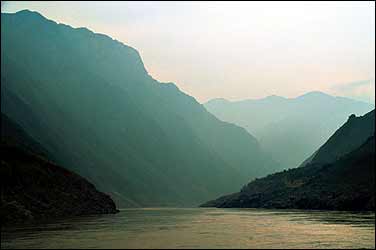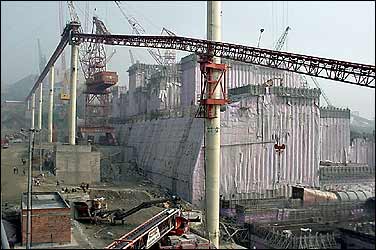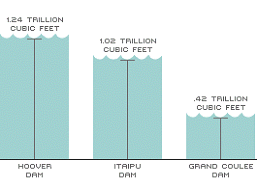

Vital Statistics:
Location: Three Gorges, China
Completion Date: 2009
Cost: $17-$100 billion
Reservoir Capacity: 1.39 trillion cubic feet
Type: Gravity
Purpose: Flood Control, hydroelectric power, irrigation, navigation
Reservoir: not named
Materials: Concrete
Engineer(s): Changjiang Water Resources Commission; Zhongnan Investment &
Design Institute; Huadong Investment & Design Institute
Construction is now under way in China on what will be the world's largest
hydroelectric dam. When it is completed in 2009, Three Gorges Dam will stretch
more than one mile across the Yangtze River and soar 600 feet above the valley
floor. It will be the largest concrete dam in the world, and will produce
18,000 megawatts of electrical energy, nudging Brazil's Itaipu Dam to second
place.

China's Three Gorges Dam is years from completion, but environmentalists and
human rights advocates are already concerned about the consequences of such
a huge structure. To make way for the enormous project, more than one million
people living on the banks of the Yangtze River will have to move to higher
ground. The 350-mile-long reservoir will submerge villages, ancient temples,
burial grounds, and the spectacular canyons that tourists from all over the
world come to see. Environmentalists also argue that the dam will wipe out a
number of rare species, including the Yangtze River dolphin, and that the reservoir
will trap millions of tons of raw pollutants spewing from China's largest industrialized
city, Chongqing.
When finished, Three Gorges Dam will generate one-ninth of China's power. Unfortunately, the dam may be remembered not for its hydroelectric power, but for its drastic social and environmental impact.
Here's how this dam stacks up against some of the biggest dams in the world. (reservoir capacity, in cubic feet)

Fast Facts: